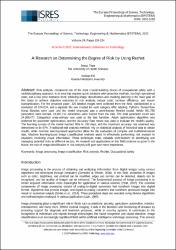| dc.contributor.author | Tepe, Serap | |
| dc.contributor.author | Eti, Serkan | |
| dc.date.accessioned | 2024-03-01T06:09:35Z | |
| dc.date.available | 2024-03-01T06:09:35Z | |
| dc.date.issued | 2023 | en_US |
| dc.identifier.citation | Tepe, S. ve Eti, S. (2023). A research on determining the degree of risk by using ResNet. 3rd International Conference on Technology, IConTech 2023 içinde (126-134. ss.). Antalya, 16-19 November 2023. https://dx.doi.org/10.55549/epstem.1406264 | en_US |
| dc.identifier.isbn | 9786256959255 | |
| dc.identifier.issn | 2602-3199 | |
| dc.identifier.uri | https://dx.doi.org/10.55549/epstem.1406264 | |
| dc.identifier.uri | https://hdl.handle.net/20.500.12511/12331 | |
| dc.description.abstract | Risk analysis, considered one of the most crucial building blocks of occupational safety with a multidisciplinary approach, is an area that requires quick solutions with proactive methods, has high operational costs, and a low error tolerance level. Utilizing image classification and enabling learning is the main goal of this study to achieve objective outcomes in risk analysis, reduce costs, increase efficiency, and ensure standardization. For the proposed paper, 325 labeled images were collected from the field, standardized to a resolution of 224x224, and a separate file was created for each category after labeling. Python's TensorFlow Keras libraries were used, and the model employed was a semi-learned ResNet model. While 501,765 parameters were learned, 23,587,712 parameters were trained from the data. The total parameter count was 24,089,477. Categorical cross-entropy was used as the loss function, Adam optimization algorithm was preferred for parameter optimization, and the Accuracy Rate metric was used to evaluate the model's quality. The learning success of the model reached 58% in 100 steps, and the maximum accuracy rate observed was determined to be 67%. Traditional risk analysis methods rely on statistical analysis of historical data to obtain results, while machine learning-based approaches allow for the evaluation of complex and multidimensional data. Machine learning-based image classification methods assist in effectively performing risk analysis in situations involving visual information. These techniques make valuable contributions to identifying and managing potential risks in different sectors. As research and applications in this field continue to grow in the future, the role of image classification in risk analysis will gain even more importance. | en_US |
| dc.language.iso | eng | en_US |
| dc.publisher | ISRES Publishing | en_US |
| dc.rights | info:eu-repo/semantics/openAccess | en_US |
| dc.subject | Image Processing | en_US |
| dc.subject | Image Classification | en_US |
| dc.subject | Risk Analysis | en_US |
| dc.subject | ResNet | en_US |
| dc.subject | Occupational Safety | en_US |
| dc.title | A research on determining the degree of risk by using ResNet | en_US |
| dc.type | conferenceObject | en_US |
| dc.relation.ispartof | 3rd International Conference on Technology, IConTech 2023 | en_US |
| dc.department | İstanbul Medipol Üniversitesi, İMÜ Meslek Yüksekokulu, Bilgisayar Programcılığı Ana Bilim Dalı | en_US |
| dc.authorid | 0000-0002-4791-4091 | en_US |
| dc.identifier.volume | 24 | en_US |
| dc.identifier.startpage | 126 | en_US |
| dc.identifier.endpage | 134 | en_US |
| dc.relation.publicationcategory | Konferans Öğesi - Uluslararası - Kurum Öğretim Elemanı | en_US |
| dc.identifier.doi | 10.55549/epstem.1406264 | en_US |
| dc.institutionauthor | Eti, Serkan | |
| dc.identifier.scopus | 2-s2.0-85184586187 | en_US |


















